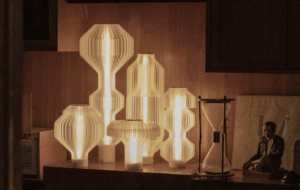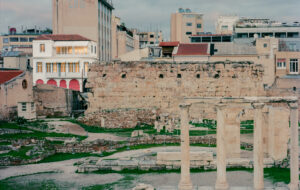

words Alex Wiltshire
Brutal, beautiful and big: the long-awaited addition to the Grand Theft Auto series smears a bloody hand over the boundaries between shoot-’em-up, social satire and morality play.
The sun dawns brilliant orange across another day on Grove Street in Ganton, Los Santos, revealing the decaying clapboard houses of my exhausted neighbourhood.
I steal a car and drive over to Burger Shot for food, then to the barber’s to get – cornrows? No, a blonde Afro. I stride outside the shop to witness another police shootout. The black guy in the red basketball top falls and the police scream away, mowing down an old woman. I go over to Smoke’s.
The sun is now casting a jaundiced haze over the bent telegraph poles and screaming freeway next to Smoke’s house. He has a task – we’re to drive up to the motel for a meeting in Jefferson with the other local family gangs.
We arrive as twilight falls. Jefferson is closer to the rich heights of Mulholland where Case Study Houses fight for space on the hillside. Parked in the lot we hear the distant throb of a police helicopter and they’re suddenly raiding us. I die in a scattering of buckshot.
San Andreas is the latest iteration of the massively popular “crime simulator” series, Grand Theft Auto. Until now, they have been set in just one city, but San Andreas is the recreation of an entire state: three cities – direct analogues of early 1990s Los Angeles, San Francisco and Las Vegas – plus the farmland, mountains, deserts, forests and small towns between them.
At the start of the game you can only access Los Santos, the brutal and unrelenting pantomime LA of NWA and Falling Down. It is initially bewildering and threatening; the area is enormous, encompassing acres of countryside plus three small towns and a full city, with commercial areas, beaches and an airport. But as you learn skills – how to drive, how to target and shoot – and learn the city itself, your confidence and ambitions swell in tandem to the game story of the small-time hood becoming a playa.
Like its immediate predecessor, Vice City, which was set in the neon and cocaine 1980s glitz of Crockett and Tubbs’ Miami, San Andreas uses an incredible array of devices to generate its enveloping sense of place and time. Architecture defines the different areas: skyscrapers downtown, projects in the ghetto, villas on the hillsides and low rise gridded hick towns. These identities are honed by the clothes people wear and the types of car they drive.
And then there are the radio stations, which play a range of true-to-the-era hip-hop, rock, soul and country on car stereos. Between the music, the DJs breathe life into a full culture that refers to itself and to the previous games. You’ll hear adverts for places that you can visit and hear about characters you’ll eventually meet. Breathless news stories report your own actions as you progress through the game plot.
The radio, along with places like Ammu-nation (the gun shop) and fast food restaurants reveal San Andreas to be a satire based on a stereotype of modern America: an amoral cesspit of violence, racial and social division, gluttony, drug use and gas.
Its heavily ironic style is frequently very funny, perhaps especially to Europeans, who tend to understand America in terms of stereotypes anyway. The game was actually developed in Scotland by Rockstar North. A distinctly British sense of humour runs throughout, with both Viz-style sexual euphemisms, like the Camel’s Toe casino, and surprising subtlety. That cultural distance may have helped the creators define such a distinct and focused world, but the game has had a wide appeal in the US, from East Coast intellectuals to bored Midwestern teens.
The range of different media that San Andreas draws on makes its satire extremely powerful – it infuses everything players see and hear and it directly affects their actions. It’s hard to think of any other cultural artefact that has been able to draw on such a broad world – music, the spoken word, cinema, architecture, fashion, furniture, product and car design – with such immediacy.
Testament to the power of San Andreas is that it is bound to attract the same “Daily Mail” attention as its predecessors. It’s unfortunate that some (but by no means all) of the characterisation is so crude – with a distinct homophobic edge. But more seriously, the game has mixed morals; killing is both a requirement of gameplay and derided by sympathetic characters. It’s a great pity that the developers did not open up the gameplay even more to allow the player complete freedom over whether to break such moral codes as killing.
San Andreas is more raw and more specific to a place and time than its predecessors, despite its far greater size. That the rare mix of focus and breadth is coupled with an intrinsic interactivity means that San Andreas goes beyond any other media product in creating an autonomous and credible world that feels as though it exists beyond the edges of the screen.
Grand Theft Auto: San Andreas is for PlayStation 2, priced £39.99

















